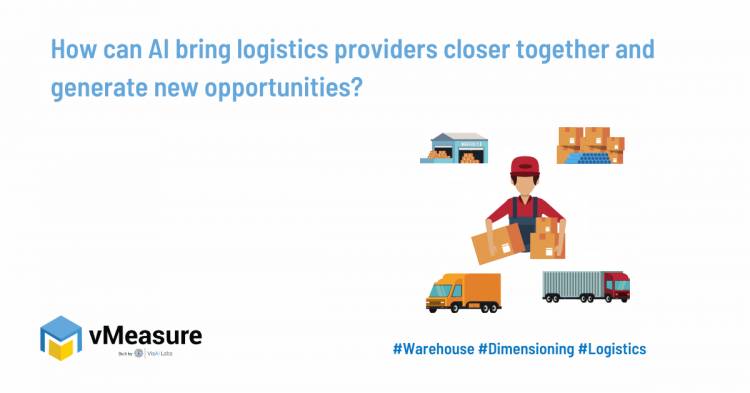
How can AI bring logistics providers closer together and generate new opportunities?
In the post-pandemic age, do you want to hasten your company's growth? On the other hand, technology improves human productivity, eliminates errors, lowers costs, and increases profitability.
We'll detail how artificial intelligence (AI) improves operational effectiveness, fills in gaps, and opens up opportunities for retailers, supply chain managers, and logistics service providers in this whitepaper. Then, to outperform your rivals, you must use innovation and technology. However, a significant worry needs to be addressed before moving forward. People frequently believe that technology will replace employment held by people. Believe us. That is untrue.
AI, eCommerce, and logistics:
Today, people emphasize safety instead of visiting brick-and-mortar stores and prefer to shop online due to its enticing offers. The number of new online shoppers is expected to increase by over 150 million in 2020 alone, resulting in a peak in eCommerce sales. In fact, the eCommerce sector is predicted to grow at a 7.9% CAGR to reach USD 6.2 trillion by 2027. Therefore, it is anticipated that the development prospect for warehouses and logistics providers would be truly revolutionary. They must increase operational responsiveness, productivity, and efficiency to meet the rising demand.
Artificial intelligence (AI) has significantly improved the productivity and financial performance of logistics service providers and warehouses. Improving operations and customer service, lowering costs, and minimizing errors have turned warehouses and logistics into profitable hubs. In addition, AI has completely changed how dimensioning, sorting, processing, packaging, transportation, and tracking are automated, from source to delivery.
What is artificial intelligence?
Artificial intelligence (AI) refers to the cognitive intellect of machines that enables them to learn from experience, apply fresh observations, and carry out tasks similar to those performed by humans. Planning, processing, dimensioning, reasoning, problem-solving, and disseminating insight are all automated using AI.
Future of ai:
No matter the industry, AI is the rage nowadays. As we transition into post-pandemic shipping, image analysis, dimensioning, slotting, packaging, cartonization, and billing automation in 2023, AI will become fundamental to every operation. It will continue to rule important warehouse, logistics, and eCommerce services. Over 60% of G2000 manufacturing businesses are predicted to use AI platforms by 2024 to accelerate digital transformation throughout the supply chain. And productivity will rise by 20% as a result of this adoption. AI will simplify shipping, picture analysis, dimensioning, slotting, packaging, cartonization, and invoicing automation through machine learning, natural language processing, and computer vision. As a result, AI will help firms become more productive, spend less money, and become more profitable.
How is AI applied in the logistics sector?
AI enables logistics companies to streamline processes, manage expenses, cut down on damage, automate measures, and monitor shipments. It facilitates shipment consolidation, improves the possibility of price negotiations, and reduces damages, delays, and misunderstandings during freight. AI examines warehouse products and the necessity for order fulfillment, shipping, and replenishment. Real-time shipping routes can be planned, followed, and adjusted using special software. Logistics companies benefit from machine learning by analyzing datasets, controlling delivery times, anticipating future demands, and generally improving things.
Benefits of AI in logistics:
- Eliminating human blunders: It takes time and is prone to mistakes to assign teams to gather, manage, and track data. AI completes this enormous task quickly and without any mistakes. The accuracy of this data increases productivity and profitability.
- Reducing cost: AI guarantees exact dimensions, eliminates human mistakes, and reduces freight costs.
- Automating functions: AI automates laborious tasks, including product shipping, invoice data entry, delivery tracking, and monitoring.
Use case of AI in logistics:
Automated warehousing:
Artificial intelligence turns a typical warehouse into an automated profit center by streamlining data collecting, analysis, and inventory processing procedures. According to a recent poll, businesses will automate about 30% of warehouse operations to increase productivity and profitability. The automated warehouses employ computer vision technology without human control to recognize and maintain quality.
Below listed are some of the Automation solutions that play a pivotal role in logistics firms:
Automated dimensioning and weighing systems: Automated weighing and dimensioning systems efficiently reduce costs and increase profit margins. They optimize pricing, picking, packaging, storing, shipping, and distribution on several levels. An essential component of any warehouse operation is dimensioning. Accurate measuring data improve storage density by positioning things in warehouses to maximize compactness. Dimensioning and weighing systems, which are practical for conveyors and other automation equipment, evaluate design precision based on product parameters, including height, breadth, width, and weight. Its high-speed printing facility quickly scans, weighs, and processes dimensions to print and affix carton shipping labels for quick and simple shipments. Shipping a truckload or precisely cubing out pallets can save time, money, and work.
Benefits of deploying an automated dimensioning and weighing system in your workspace:
- Increased accuracy: By measuring accurately, your business can generate higher income by reducing inaccuracies in shipping tariffs.
- Improved space optimization: In warehouses, space is equivalent to money. Systems for automated dimensioning and weighing systems that provide precise volumetric measurements aid in optimizing space allocation. The item is placed thanks to these values optimally.
- Reduced human error: In traditional dimensioning, the tape and ruler are utilized to calibrate the parcel's DIMs and weight information. These are prone to human errors and lead to higher freight charges. With automated dimensioning and weighing systems, manual errors can be entirely cut down, thanks to the high-level algorithms.
Automated robots: Automated robots are technologies that are used to move materials, carry out jobs, and speed up warehouse operations. These intelligent robots are essential to effective warehouse operations because they eliminate repetitive work and allow workers to concentrate on challenging jobs that call for human intelligence. Popular examples of robots in warehouses are Automated Guided Vehicles, Automated Storage, and Retrieval Systems.
Benefits of deploying automated robots in the logistics industry:
- Increased speed and scalability: Robust automated robots get many repetitive tasks done in the shortest timeframe. Robots can quickly scale up and down based on the urgency of orders.
- Decreased human blunders: Human errors can be quite costly for businesses. Robots reduce human errors and help boost productivity, customer satisfaction, and profitability.
Drones:
Drones are ingenious flying machines that facilitate surveillance and transport of goods in the air. These Unmanned Aerial Vehicles (UAVs) use optical sensors to improve warehouse and logistics procedures. They can swiftly detect an item, scan RFID tags, determine inventory levels, and transfer all the information to the Warehouse Management System from a distance of a few meters.
Procuring drones in the logistics industry has many advantages:
- Aids inventory management and monitoring warehouse movement
- Accelerates delivery.
- Operates 24/7 for greater productivity.
Autonomous vehicle:
The fundamental idea behind autonomous vehicle technology is that moving vehicles should be operated without or with very little human interaction. In many warehouses, autonomous mobile robots (AMRs) are commonplace and aid personnel in rapidly and effectively completing orders. They choose optimization functions and manage fleets with ease. One of the main issues with autonomous self-driving vehicles is managing employee interaction. Some workers worry that bots will obstruct them, creating delays and hazardous working conditions. However, this anxiety only exists before deployment. The workers are no longer concerned after they become acclimated to self-driving cars and scurrying robots.
Utilizing artificial intelligence in backend operations: Most transportation planning and administration is done in the back office. All data-related processes and accounts can be efficiently automated with cognitive automation, a combination of Robotic Process Automation (RPA) and AI tools. As a result, AI in the backend boosts accuracy and productivity while decreasing human error.
Increasing customer satisfaction and predicting demand:
Demand forecasting offers the potential to boost profits. AI is useful now for predicting the demand for a specific product. Orders can be recorded and adjusted based on this data. Delivering the in-demand commodities to the neighborhood warehouse can be the focus of your efforts. Logistics planning and automated demand forecasting have a significant impact on reducing freight and operating expenses. In addition, AI increases customer happiness by automating back-office tasks and personalizing client service and delivery. Incorporating AI-driven customer devices gives customers omnichannel experiences that are more flexible and individualized for order placement, payment, and delivery.
Creating opportunities for logistic providers through artificial intelligence:
Today the pandemic has drastically changed the social and commercial climate. eCommerce, warehousing, and logistics companies have started employing AI in their workspace to fill the gaps left by economic and social variables. AI provides businesses with the ideal opportunity and platform to develop and implement strategies because it is equipped with real-time information, cutting-edge technology, and creativity. As a result, firms can achieve significant cost reductions by employing improved demand management methods, product storage, distribution, and customer engagement. In addition, by utilizing data platforms and generating datasets that control paradigms and anomalies, AI also aids in the transformation and acceleration of your warehousing operations.
Conclusion:
Supply chain management and logistics firms benefit from increased productivity, efficiency, and profitability thanks to AI. Without a doubt, the use of AI in logistics offers many prospects for corporate expansion.












